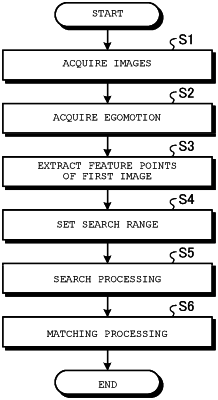| CPC G06F 18/22 (2023.01) [G06T 7/73 (2017.01); G06V 10/40 (2022.01); H04N 5/76 (2013.01)] | 12 Claims |

|
6. An image processing method for determining a motion of an object in a three-dimensional space from a plurality of time-series images captured by a camera, the image processing method comprising:
(a) acquiring the plurality of time-series images;
(b) extracting a feature point corresponding to the object from a first image of the time-series images;
(c) setting a search range for a point corresponding to the feature point in a second image of the time-series images that was captured immediately after the first image;
(d) searching for one or more candidates of the point corresponding to the feature point within the search range in the second image;
(e) if there is one candidate of the point identified in the search, associating said one candidate with the feature point; and
(f) if there are a plurality of candidates of the point identified in the search,
acquiring a score of each of the candidates and distances between all pairs of the candidates in the second image,
if none of the distances exceeds a threshold, associating one of the candidates having a greatest score with the feature point, and
if any one of the distances exceeds the threshold, associating none of the candidates with the feature point, wherein
the image processing method further comprises, after performing (b)-(f) on all the time-series images:
determining three-dimensional coordinates of the object corresponding to each of the time-series images in which the candidate has been associated with the feature point, using coordinates of the candidate in said each of the time-series images; and
determining the motion of the object using the determined three-dimensional coordinates of the object.
|